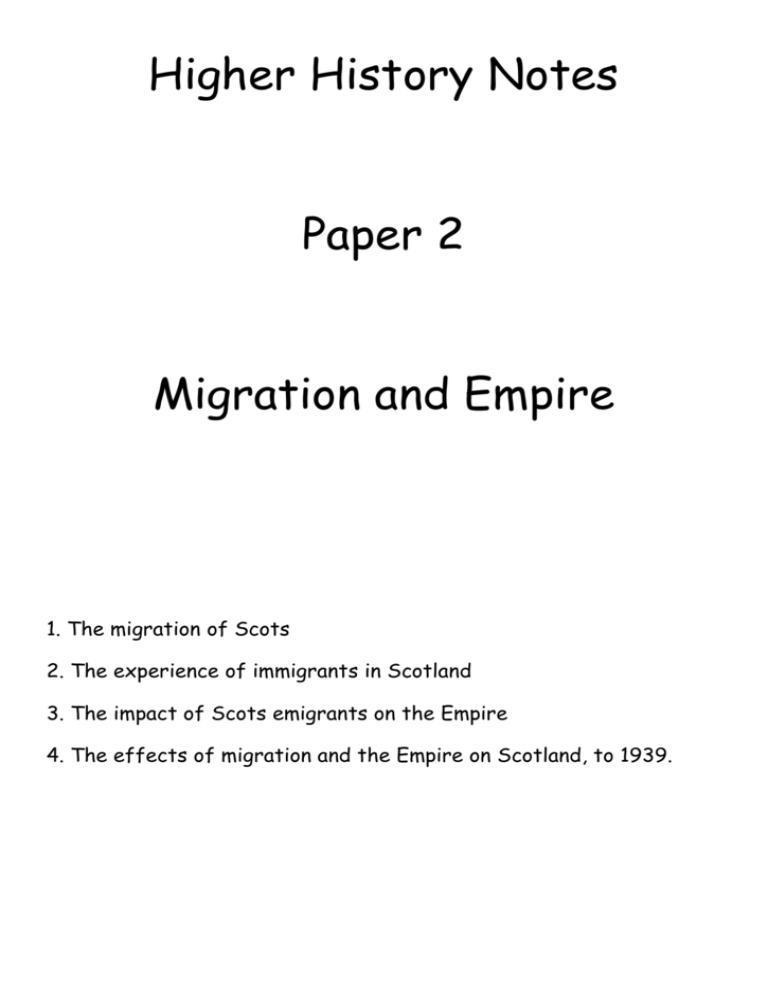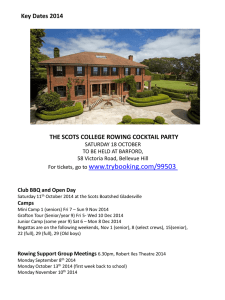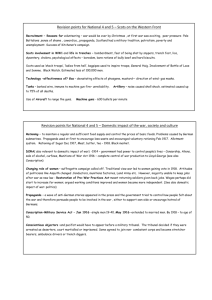Higher History Notes Paper 2 Migration and Empire 1. The migration
advertisement

Higher History Notes Paper 2 Migration and Empire 1. The migration of Scots 2. The experience of immigrants in Scotland 3. The impact of Scots emigrants on the Empire 4. The effects of migration and the Empire on Scotland, to 1939. 1. The migration of Scots How fully . . . the reasons for the migration of Scots? How far . . . the reasons for internal migration within Scotland? How far . . . the opportunities that attracted Scots to other lands? How far . . .the factors that forced Scots to leave Scotland? Highlands 1) Highland Clearances (1840s) Growth in demand for wool and mutton led to increase in profits for sheep farming. Many landlords in the Highlands decided to remove small tenants and crofters from their estates in order to make room for sheep farmers, who could pay higher rents.Those evicted were forced to move to the Lowlands or to the fishing villages of the northern and eastern coasts. 2) Potato Blight (1846) The potato crop was decimated in the Highlands, especially in the north-west. 200,000 were threatened with starvation. Many were forced to move south to look for work. 3) Decline in Kelp Industry Kelp was used to make soap. It was a very labour intensive industry (50,000 Highlanders were employed in harvesting kelp at its peak). However, the use of chemicals to make soap led to a decline in the industry and forced many to move. 4) Growth of deer forests These were set up to replace sheep farms. They did not require many workers and increased migration from the Highlands. 5) Decline of the fishing industry This had been a boom industry for much of the 1800s. However, during World War 1 many fishing boats were taken over by the navy and fishing stopped in the North Sea. When the war finished, many boats were damaged. In addition, fuel costs rose. Finally, the huge Russian market for herring declined after 1917. 6) Pressure on Land Culture of sub-division of land and sub-letting led to smaller and smaller farms. These were unable to support a growing population, leading to greater pressure on Highlanders to migrate. Many landlords banned sub-letting of land and keeping lodgers. This meant that anyone who got married had to leave the croft, increasing migration. 7) Living Conditions Highland blackhouses did not improve at the same rate as Lowland housing. Conditions were poor as many houses were damp, dark, smoky, shared with livestock and lacking in proper sanitation or running water. As a result, diseases such as Typhus and TB were common. 8) Temporary Migration There was a very active seasonal labour market in the Lowlands which enabled Highlanders to migrate for part of the year. The traditional period of migration was May to September and the key areas of employment were agricultural work at harvest time, building and railway navvying. Lowlands 9) Changes in land organisation In the Lowlands, farms became larger and smaller 'family farms' disappeared. Farm workers would hire out their labour for 6 or 12 months at a time. As the farmer was forced to pay wages and provide lodging, he was unlikely to employ more workers than he needed. In addition, this meant that farm workers were used to 'flitting' regularly and so were more inclined to migrate greater distances than they had been before. 10) Accommodation tied to jobs Both single and married farm workers were accommodated on the farm, so to be without work was to be without a place to stay, forcing migration. 11) Overpopulation The population in the rural Lowlands had been rising by 10% per decade. This put pressure on food resources and forced many to migrate. 12) Farm Machinery New machinery on farms meant that fewer farm labourers were needed. This new technology included the self-binding reaper and steam thresher. This lack of jobs in manual labour encouraged many people to move. 13) Higher wages in the city Urban areas provided higher wages than those available in rural areas. An industrial worker in a town or city might earn up to 50% more than an agricultural labourer. These wages could also be earned by working shorter hours than on a farm. 14)'Bright Lights' The cities provided a more varied social life than the countryside. This was particularly attractive to younger people, who were encouraged to move by the prospect of visiting cinemas, theatres, dances or sporting events. 15) Decline of cottage industries Small industries in towns were severely impacted by the growth of large factories in the towns and cities. These could supply products cheaply, especially with the growth of the railways. Traditional workers, such as tailors and shoemakers, could not compete with factory-made products. The smallscale textile industries were also particularly badly hit by the growth of power looms. Other reasons 16) Railways The growth of railways was important in aiding migration as it allowed people to move quickly and cheaply. It also boosted the population of the Borders towns by allowing their textile industry access to new markets. 17) Changing attitudes The growth in the standards of education meant that more people were eager to leave their homes and seek employment elsewhere. It also allowed them a wider choice of jobs. After the Great War, many soldiers who had experienced life abroad were now keen to try life elsewhere. Causes of Emigration Many of the reasons for migration within Scotland were also responsible for causing emigration. 1) 2) 3) 4) 5) 6) 7) The Highland Clearances The potato famine Agricultural changes in the Lowlands Poor living conditions in the Highlands Overpopulation in both the Lowlands and Highlands Changing attitudes brought about by higher standards of education The decline in the fishing and kelp industries However, there were a number of other causes of emigration. a) Agricultural Depression The westward expansion of America during the 19th century led to a huge increase in wheat production. In addition, the development of refrigerated shipping allowed meat to be imported from the Empire (especially lamb from New Zealand). These both served to undercut Scottish farmers, leading to more Scots leaving. b) Economic insecurity in cities Scotland's economy relied heavily on exporting manufactured goods. When other countries weren't buying these goods, there was increased unemployment. There were particularly severe slumps after the First World War and between 1929-32. The highest emigration figures occurred during these periods. c) Transportation Until 1867, criminals could be sent to Australia. Here they were forced to live in convict settlements. d) Higher Wages Scotland was a low wage economy. This meant that in 1900, skilled Scottish craftsmen were earning 10-15 % less than their English counterparts. By moving to countries such as Australia and Canada, these craftsmen could increase their wages a great deal. e) Steamships The invention of the steamship allowed for much easier and safer travel for those wishing to emigrate. In 1860, a journey from Glasgow to New York took 6 weeks. By 1900 the same journey took one week. This increased emigration as it provided folk with the security of knowing that they could always return home. More importantly, it allowed skilled tradesmen the opportunity to move to North America for the season to earn more money, before returning to Scotland for the rest of the year. f) Education Scotland had a tremendous education system which produced a workforce at the cutting edge of the global economy. This meant that their services were in high demand, and they found it relatively easy to find work abroad. Many of the Scots who emigrated were professionals, such as doctors or lawyers. g) Official Assistance Many poorer Scots could not afford the cost of emigration. However, they were given assistance by emigration societies, such as the Highland and Islands Emigration Society. These societies helped landlords to resettle people by subsidising their passage. Under the scheme, a landlord could secure passage to Australia for a nominee at the cost of £1. Later on, the 1922 Empire Settlement Act provided government subsidies for people wishing to emigrate. h) Emigration Agents Agents from around the Empire would tour Scotland, advertising their country as a desirable destination. In addition, adverts appeared in newspapers promoting emigration. They promised a better lifestyle and greater opportunity abroad. The prospect of free land was also common. i) Relatives Abroad As the number of Scots abroad increased, it became easier for other Scots to join them. They could offer temporary accommodation and often employment to new migrants, making the prospect of emigration less daunting. In addition, successful emigrants would often write home, describing their success and encouraging family members and friends to join them. 2. The experience of immigrants in Scotland How fully . . . the experience of immigrants in Scotland? How far . . . the social and economic conditions experienced by immigrants to Scotland? How far . . . relations between native Scots and immigrants? How far . . . the assimilation of immigrants into Scottish society? Social and Economic Conditions Italians The Italians in Scotland quickly became committed to the catering trade and brought new consumer delights to the working class – ice- cream parlours and fish and chip shops. They were a huge attraction for young people who wanted somewhere to meet. Italian families contributed to the growing leisure industry. In 1903 there were 89 cafés in Glasgow, growing to 336 by 1905. Italian families settled in many towns on the coast and in the main towns. The Nardini family developed what was to become the largest café in Britain. Small sea side towns also had their own Italian cafés. Not only cafés – In the late 1920s the College of Italian Hairdressers was set up in Glasgow. Jews Jews settled in central Glasgow, typically setting up small businesses. Cigarette making was a common job for the Jewish immigrants to Scotland. Jewish tailors helped produce affordable, quality clothing. Irish The immigrant Irish had a positive economic effect on Scotland. Irish labourers were prepared to tackle the hardest of jobs. The immigrant Irish contributed to the building of roads, canals and railways across Scotland. Irish immigrants also worked as farm labourers, in the jute mills of Dundee and in coal mining. Effect of migration on Scottish sporting life – Edinburgh Hibernian was founded in 1875 by Irishmen living in Edinburgh. Glasgow Celtic was founded in 1887 by Brother Walfrid, a Catholic priest. Dundee United was founded in 1909 and was originally called Dundee Hibernian. Existence of Protestant Orange Lodge order. Irish immigrants and their descendants were important in the Scottish Trade Union movement and the development of the Labour Party in Scotland. By the 1890s, both Catholic and Protestant Irish were gaining apprenticeships and beginning to move up the social ladder. The Irish community produced important political leaders like John Wheatley and James Connolly. Lithuanians Lithuanian immigrants were largely employed in the coal industry. They did introduce a vital household feature to Scotland – the duvet. Relations between Scots and Immigrants Catholic Irish Acted as strikebreakers and kept wages down in the early period; however they became active in the labour movement later. The (Catholic) Irish were everything the Scots did not want to be; seen by Scots as less than patriotic – Pope is seen to be ultimate authority on earth and not the British monarchy – perceived as a threat to Scottish way of life generally. Resented and mistrusted for keeping their old traditions and customs, and for having separate schools. There was disdain from native Scots towards Catholic Irish, who were often seen as drunken and superstitious. They were blamed for crime, especially the navvies. Protestant Irish More accepted into Scottish society – religion not an issue in Protestant Scotland. They also had the benefit of having family ties already in Scotland. Because many had Scottish sounding surnames, they did not stand out as much as the Catholic Irish. Lithuanians Scots were worried because Lithuanians tended to settle together. This led to them being accused of starting ‘colonies’. They were accused of being immoral and dirty (partly because they were not Protestant. Scots workers accused the Lithuanians of driving down wages and of breaking strikes (especially in mining). However, Lithuanian miners soon began to join trade unions, and to take part in strikes to improve the conditions for all miners. Italians Accepted into Scottish society fairly readily, providing a service through cafes and fish and chip shops. They were not competing with Scottish workers and were not clustered in small areas. Some Scots resented the Italians for opening their businesses on a Sunday and called them ‘sabbath breakers’. However, others felt that they offered a better alternative than establishments that sold alcohol. There was some verbal racism – Italians were referred to as ‘dirty tallies’ at times. Italians suffered hostility in the years before World War II as concerns grew about Mussolini’s actions. Jews Prejudice and discrimination affected the Jews in Scotland – The Daily Record – Aug 1905 ‘Alien Danger: Immigrants infected with loathsome disease’. They were accused of exploiting workers in ‘sweated trades’. Anti-Semitism never that widespread, possibly owing to low numbers of Jewish immigrants in relation to other groups. Very few Jews received any help from local poor relief. It was members of the Jewish community that helped each other e.g. The Glasgow Jewish Board of Guardians and the Hebrew Ladies Benevolent Society in 1901 were dealing with 500 cases of needy Jews. This meant that Scots did not view Jewish immigrants as a burden. The Assimilation of Immigrants Catholic Irish Assimilation Failure to Assimilate The Irish joined in early trade union activity. Irishmen led the Glasgow cotton spinners association. Also they were significant in the later trade union movements of the semi–skilled, such as the union of dock labourers. Catholic immigrants set up their own schools. This meant that communities did not assimilate. Many Irish were involved in the growth of working class movements fighting for better conditions for the working classes. John Wheatley for example set up the Catholic Socialist Society and became a minister in the first Labour Government. New immigrants tended to settle in areas with other Irish immigrants, meaning that they did not assimilate. Catholic Irish immigrants had their own separate churches, with priests from Ireland. Some priests encouraged their congregation to marry only within their own communities. The Irish and those of Irish descent were united with the Scots in the battlefield of WW1. They fought alongside each other. Friendships were formed in the face of a common enemy. In the field of battle, but also at home, a united front brought people together. Protestant Irish Irish Protestants had a lot in common with the average Scot – long term and deeply embedded cultural interaction between Ulster and lowland Scotland. Much easier assimilation because of shared religion. There were strong family ties between Scots and Protestant Irish immigrants. Over time this increased as there was growing intermarriage between Protestant Irish and native Scots. Jews At first Jews did not assimilate as they settled together (mainly in the Gorbals) and worked in their own industries (tailoring, hawking). Many spoke Yiddish and read Yiddish newspapers. However, by the 1920s there was greater assimilation. The Yiddish language began to die out, as did Yiddish newspapers. Middle-class Jews moved out of the Gorbals and into the suburbs. They also began to move into the same jobs as Scots, such as medicine and the legal profession. Italians Assimilation of Italians helped by popularity of ice cream parlours and fish and chip shops. Young Italians soon adopted local speech patterns due to frequency of contact in catering trade. However, many Italians did not want to assimilate. They hoped to make enough money to return home, and so made little effort to assimilate. They spoke Italian at home, ate Italian food and were expected to marry other Italians. Italians also socialised in their own clubs such as La Casa del Fascio in Glasgow. Lithuanians At first Lithuanians made little effort to assimilate. There were separate Lithuanian newspapers, shops and insurance societies. Many Lithuanian women did not learn to speak English. Evidence of the lack of assimilation was shown during World War 1, when more Lithuanians decided to return to Russia rather than fighting in the British army. However, Lithuanian miners soon began to join trade unions, and to take part in strikes to improve the conditions for all miners. Some even changed their surnames to fit in; Bernotaitis became Brown. 3. The impact of Scots emigrants on the Empire How fully . . . the impact of Scots emigrants on the Empire? How far . . . the contribution of Scots to the economic growth and development of the Empire? How far . . . the contribution of Scots to the religious and cultural development of the Empire? How far . . . the impact of the activities of Scots emigrants on native societies in the Empire? Economic Impact Canada Scots very important to the development of the Transatlantic Canadian Pacific Railway. Strong support for the railway came from Sir John A. MacDonald, the first Prime Minister of Canada, born in Glasgow. Scots were important in the financing and engineering of the project. Another Scot, Sandford Fleming, was the railway’s main engineer. The Hudson’s Bay Company recruited heavily in the Western and Northern Isles of Scotland. Scots brought new ideas on how to farm to Canada such as crop rotation. Scots were very important in the development of trade in furs and timber as well as agriculture in Canada. One of Canada’s main banks, the Bank of Nova Scotia was established by Scots. Australia Scots were important in the development of farming in Australia. They introduced the Merino sheep to the country. Scots also helped the sugar and wine industries in Australia. The McWilliams family helped to develop one of the first vineyards in Australia. Scots involved developing Australian trade, mining, manufacturing, shipping, engineering and finance. Robert McCracken from Ayrshire developed brewing in Melbourne. Robert Campbell from Greenock played such an important role in developing Australian trade that he was known as ‘The father of Australian Commerce’. Melbourne Iron works was founded by John Buncle from Edinburgh. Most importantly, Scots founded companies such as Speedos (Alexander Macrae) and Freddo Frog (McRoberts). New Zealand Scots founded New Zealand’s paper-making industry and were important engineers and shipbuilders. John Ross from Halkirk established a successful drapery business in New Zealand. David Munro introduced the first sheep to New Zealand and had a successful farm. India Charles Bruce helped to introduce commercial tea planting in India. Scots engineers helped to develop and run jute mills in Calcutta. A Scot, Lord Dalhousie, developed a plan to build railway lines to connect the main regions of India as well as build a telegraph communication system. Impact on Native Societies Australia Just as with other white immigrants, Scots' treatment of Aborigines was sometimes harsh and threatened their way of life. There were several massacres such as the Hornet Bank Massacre. Scots were prominent in the development of wool production, which involved the loss of land by aboriginal peoples. There were examples of good relations. Alec Mortimer stood up for the rights of Aborigines. There was also intermarriage, with the surnames Cameron and Campbell still existing in Aboriginal communities. New Zealand Scots initially had good relations with the Maori people. Maori’s helped Scots through their first harsh winters and freely sold them land. Some Maori’s were converted to Christianity by Scots ministers. However, some Scots began to move onto land that was not theirs, leading to the Maori Wars. Many Maori were killed during these conflicts. Scots also cleared the land of trees, which were sacred to the Maori. Donald Maclean learned the Maori language and aimed to protect their rights to land. India Scots abolished suttee (human sacrifice) and thuggee (ritual murder). They also pushed for changes in Indian attitudes towards women e.g. development of first schools for females/girls. Scots played a great role in putting down the ‘Indian Mutiny’, and acted with enormous brutality. Indian mutineers were forced to lick the blood of their victims and were strapped to cannons. Canada Scots working for the Hudson Bay Company traded and mixed with native peoples. There was intermarriage between the groups. Children of these marriages were known as the Metis people. Some Scots forced native people off their land. They also killed the bison, one of the native people’s main food sources, as well as bringing diseases such as smallpox which the native people had no immunity to. Impact on Culture and Religion Canada Several Prime Ministers were Scottish, including Canada’s first PM, John MacDonald. Scots helped to establish schools and colleges e.g. University of Toronto was established by James Strachan. Scots brought their hobbies over. Curling became a popular sport in Canada. Highland Games were popular across Canada. Canadian regiments wore kilts into battle during the First World War. Australia There a large number of Scottish societies and Burns clubs. Two of Australia’s national songs, ‘Waltzing Matilda’ and ‘Advance Australia Fair’ were written by Scots. Catherine Spence helped to promote women’s rights in Australia. She was the country’s first female political candidate and first female journalist. Scots helped to establish education in Australia. Melbourne Academy was founded by Scots and is known as Scotch College. New Zealand Dunedin was established by Scots and means Edinburgh in Gaelic. It has the same street names as Edinburgh and much of the same architecture. James MacAndrew helped to found a large number of schools, as well as the University of Dunedin. Reverend Thomas Burns helped to set up the Free Church in Otago province. There are still many Caledonian societies and pipe bands in New Zealand today. India Suttee, where a widow was burned alongside her dead husband, was banned by Dalhousie. He also hanged hundreds of Thugees, who would attack, murder and rob travellers. Reverand Alexander Duff helped to found the University of Calcutta. Flora Annie Steel toured the country, inspecting schools and delivering lessons to girls. Scots also helped to found medical colleges, such as Grant Medical College in Bombay. 4. The effects of migration and the Empire on Scotland, to 1939. How fully . . . the effects of migration and the Empire on Scotland? How far . . . the social and cultural impact of immigrants on Scotland? How far . . . the economic contribution of immigrants to Scotland? How far . . . the importance of the Empire to Scotland’s development? The Empire was important to Scotland’s development in several ways. Some were positive. Empire enabled some firms and individuals to make great commercial fortunes. An example would be the Clyde shipbuilders like Napier’s and John Brown’s. The jute industry in Dundee also benefited. The raw material came from the Indian province of Bengal. The textile manufactured from this imported good was then exported all over the world. Empire offered a market for Scottish goods. For example, Springburn, produced one quarter of the world’s locomotives in 1914. Scots exploited employment opportunities offered by Empire: Scottish middle-class men had successful careers, especially in India, as civil servants, doctors and as soldiers. As a result of the Empire offering a wide variety of jobs, Scotland developed a skilled, literate working class in trades such as engineering. Scottish investors pioneered the use of ‘investment trusts’, where professional managers enabled large numbers of modest investors to gain access to the rewards of large-scale investment. Cities like Edinburgh, Dundee and Aberdeen came to hold extensive investments abroad. Glasgow made so much money from trade that it became known as the second city of the Empire. Scots returning from the Empire often built large mansions in or near the cities eg Broughty Ferry in Dundee. However, investment was a double-edged sword as it also meant that money left Scotland to finance projects abroad. And because Scotland relied on exporting goods to the Empire, it became vulnerable to international trade slumps. In addition, Scottish firms paid low wages in order to make their products cheaper for export. This led to considerable poverty for many with associated problems of poor housing and poor health. Scotland’s economy also suffered as foreign agriculture became more productive and countries such as New Zealand (lamb) and Canada (wheat) were able to undercut Scottish farmers. Culturally, the Empire had a noticeable impact on Scots. New words entered the language, such as ‘bungalow’ and ‘thug’ from India. Scots also developed a military tradition, and many Scots chose to join the army to follow in the footsteps of famous officers such as Sir Colin Campbell.







